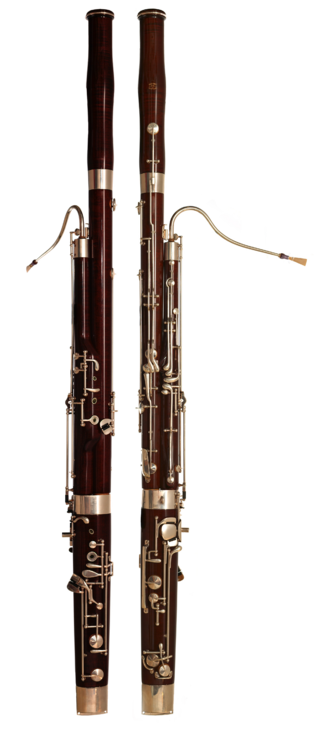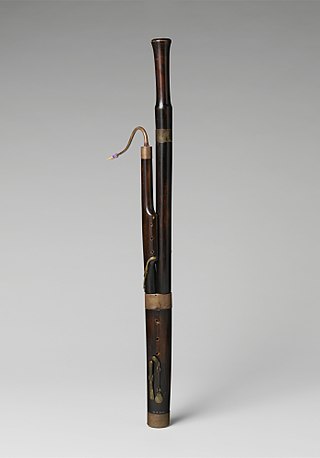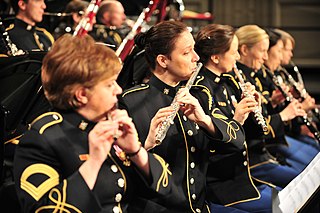
The bassoon is a musical instrument in the woodwind family, which plays in the tenor and bass ranges. It is composed of six pieces, and is usually made of wood. It is known for its distinctive tone color, wide range, versatility, and virtuosity. It is a non-transposing instrument and typically its music is written in the bass and tenor clefs, and sometimes in the treble. There are two forms of modern bassoon: the Buffet and Heckel systems. It is typically played while sitting using a seat strap, but can be played while standing if the player has a harness to hold the instrument. Sound is produced by rolling both lips over the reed and blowing direct air pressure to cause the reed to vibrate. Its fingering system can be quite complex when compared to those of other instruments. Appearing in its modern form in the 19th century, the bassoon figures prominently in orchestral, concert band, and chamber music literature, and is occasionally heard in pop, rock, and jazz settings as well. One who plays a bassoon is called a bassoonist.

The oboe is a type of double-reed woodwind instrument. Oboes are usually made of wood, but may also be made of synthetic materials, such as plastic, resin, or hybrid composites.

Woodwind instruments are a family of musical instruments within the greater category of wind instruments.

A reed is a thin strip of material that vibrates to produce a sound on a musical instrument. Most woodwind instrument reeds are made from Arundo donax or synthetic material. Tuned reeds are made of metal or synthetics. Musical instruments are classified according to the type and number of reeds.

The sarrusophones are a family of metal double reed conical bore woodwind instruments patented and first manufactured by French instrument maker Pierre-Louis Gautrot in 1856. Gautrot named the sarrusophone after French bandmaster Pierre-Auguste Sarrus (1813–1876), whom he credited with the concept of the instrument, though it is not clear whether Sarrus benefited financially. The instruments were intended for military bands, to serve as replacements for oboes and bassoons which at the time lacked the carrying power required for outdoor marching music. Although originally designed as double-reed instruments, single-reed mouthpieces were later developed for use with the larger bass and contrabass sarrusophones.
C. G. Conn Ltd., Conn Instruments or commonly just Conn, is a former American manufacturer of musical instruments incorporated in 1915. It bought the production facilities owned by Charles Gerard Conn, a major figure in early manufacture of brasswinds and saxophones in the USA. Its early business was based primarily on brass instruments, which were manufactured in Elkhart, Indiana. During the 1950s the bulk of its sales revenue shifted to electric organs. In 1969 the company was sold in bankruptcy to the Crowell-Collier-MacMillan publishing company. Conn was divested of its Elkhart production facilities in 1970, leaving remaining production in satellite facilities and contractor sources.
The bass oboe or baritone oboe is a double reed instrument in the woodwind family. It is essentially twice the size of a regular (soprano) oboe so it sounds an octave lower; it has a deep, full tone somewhat akin to that of its higher-pitched cousin, the English horn. The bass oboe is notated in the treble clef, sounding one octave lower than written. Its lowest sounding note is B2 (in scientific pitch notation), one octave and a semitone below middle C, although an extension with an additional key may be inserted between the lower joint and bell of the instrument in order to produce a low B♭2. The instrument's bocal or crook first curves away from and then toward the player (unlike the bocal/crook of the English horn and oboe d'amore), looking rather like a flattened metal question mark; another crook design resembles the shape of a bass clarinet neckpiece. The bass oboe uses its own double reed, similar to but larger than that of the English horn.
A multiphonic is an extended technique on a monophonic musical instrument in which several notes are produced at once. This includes wind, reed, and brass instruments, as well as the human voice. Multiphonic-like sounds on string instruments, both bowed and hammered, have also been called multiphonics, for lack of better terminology and scarcity of research.
Conn-Selmer, Inc. is an American manufacturer of musical instruments for concert bands, marching bands and orchestras. It is a wholly owned subsidiary of Steinway Musical Instruments and was formed in 2003 by combining the Steinway properties, The Selmer Company and United Musical Instruments.

Buffet Crampon SAS is a French manufacturer of wind instruments based in Mantes-la-Ville, Yvelines department. The company is the world market leader in the production of clarinets of the Boehm system. Its subsidiary, Buffet Crampon Deutschland GmbH, founded in 2010 and based in Markneukirchen, Vogtland, Sachsen, is the world market leader in the manufacture of brass instruments. To manufacture and sell its products, the BC Group employed around 1000 people worldwide at the beginning of 2021, 470 of them as employees of BC Germany alone. The management of the group has been in the hands of Jérôme Perrod since 2014.

The tenor bassoon or tenoroon is a member of the bassoon family of double reed woodwind instruments. Similar to the alto bassoon, also called octave bassoon, it is relatively rare.
Steinway Musical Instruments, Inc. is a worldwide musical instrument manufacturing and marketing conglomerate, based in Astoria, New York, the United States. It was formed in a 1995 merger between the Selmer Industries and Steinway Musical Properties, the parent company of Steinway & Sons piano manufacturers. From 1996 to 2013, Steinway Musical Instruments was traded at the New York Stock Exchange (NYSE) under the abbreviation LVB, for Ludwig van Beethoven. It was acquired by the Paulson & Co. private capital firm in 2013.
Marigaux, also known as SML (Strasser-Marigaux-Lemaire) is a French manufacturer of high quality woodwind musical instruments.
In music, a decet—sometimes dectet, decimet, decimette, or even tentet—is a composition that requires ten musicians for a performance, or a musical group that consists of ten people. The corresponding German word is Dezett, the French is dixtuor. Unlike some other musical ensembles such as the string quartet, there is no established or standard set of instruments in a decet.
October is a contemporary piece for concert band approximately six minutes in duration that was written by Eric Whitacre in 2000.

A woodwind doubler is a musician who can play two or more instruments from the six woodwind families, and can play more than one instrument during a performance. A player who plays two instruments from the same family is also often considered a woodwind doubler, but is usually paid less than a player who plays instruments from different families.

The woodwind section, which consists of woodwind instruments, is one of the main sections of an orchestra or concert band. Woodwind sections contain instruments given Hornbostel-Sachs classifications of 421 and 422, but exclude 423

A woodwind quartet is a musical ensemble for four woodwind instruments. Alternatively the term refers to music composed for this ensemble. The most common scoring is flute, oboe, clarinet and bassoon. The ensemble is also often used as a teaching ensemble in schools and universities and as a concertino group in a concerto grosso.

Backun Musical Services Ltd. (BMS) is a Canadian manufacturer of clarinets in bass, B♭ and A and accessories, based in Burnaby, British Columbia.

The company F. Arthur Uebel GmbH (FAU) is a German manufacturer of clarinets with headquarters in Wiesbaden and production facilities in Markneukirchen (Saxony).











